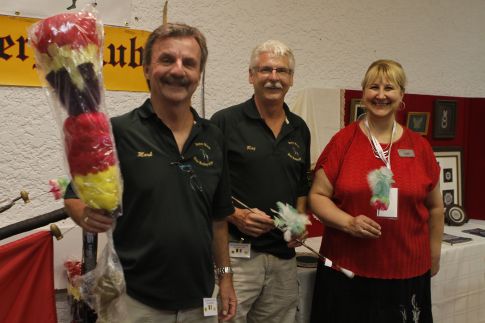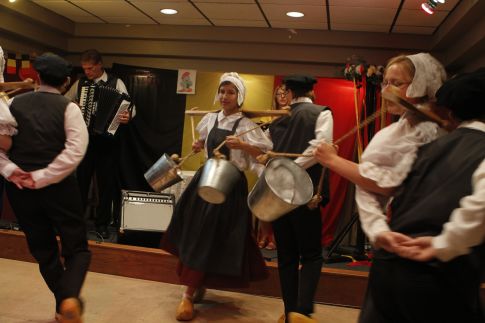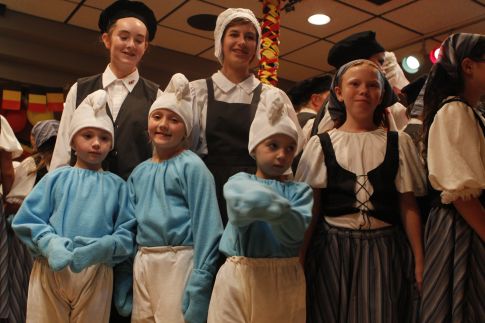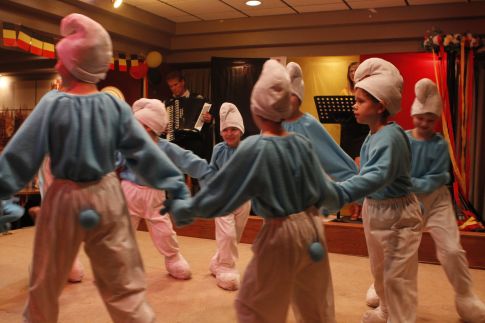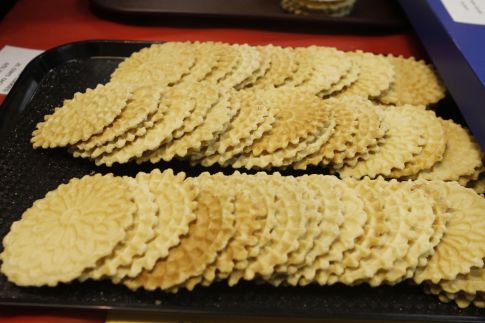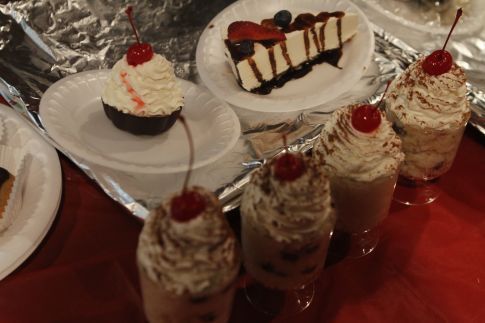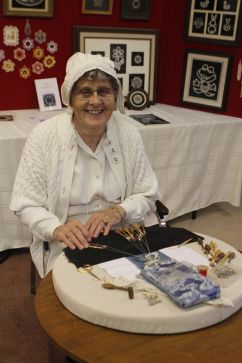 What do you think of when you hear Belgium? Four things immediately came to mind for me: lace, chocolate, beer and waffles. Of course, there’s a whole lot more but the Belgians do all four extremely well.
What do you think of when you hear Belgium? Four things immediately came to mind for me: lace, chocolate, beer and waffles. Of course, there’s a whole lot more but the Belgians do all four extremely well.
At Folkorama in August, they had a fascinating cultural pavilion in addition to a number of folk dance performances, some of which were performed by children.
For hours, I learned about Belgian bowling, pole archery, bobbin lace making (see left) and Smurfs….yes, Smurfs were invented by a Belgian. Did you know?
I bought lace when I was in Belgium many years ago and ate a whole lotta fries if I recall. What I didn’t know about was Belgian Pole Archery and sword dancing. Apparently Belgium had its own sword dancing as far back as 1389 but they stopped doing it until around 1970, when they brought it ‘back.’
This Belgian sport is is incredibly popular in Canada. Archery was the most popular sport in Flanders at the time when the majority of Belgians in Canada left the old country. Several of the larger Belgian centres have archery clubs, hold tournaments regularly and send in the results to be published in the Gazette van Detroit, next to the results of similar tournaments in other Belgian centres in Michigan and Illinois.
Belgian archery clubs practice a distinctive type of archery of medieval origin known as “popingai”, “papejay”, or, more correctly, popinjay shooting. In Manitoba for years, the form of the sport known as “pole shooting” was practised by Belgian immigrants — there’s a great book describing the sport: The Belgians in Manitoba by Keith Wilson and James B. Wyndels.
In Ontario the horizontal version of the sport is preferred, and is usually played indoors in a Belgian club, though at times it is played outdoors. There its novelty attracts attention from those who are not familiar with this Belgian sport. The goal of the sport is to shoot the “birds”, which are traditionally made of feathers or wood, but in Ontario are now made of synthetic material.
Listen to one Manitoba man’s story of how he got into the sport, a tradition he took on from his father and grandfather. He also explains a little history about Belgian archery itself.
A total of 34 30 one-point (small) birds, 2 two-point (kalle, at times locally spelled khal or kal) birds, 2 three-point (side) birds, and 1 four-point (high) bird make up a “table” or “perch” or ‘rack”. The archers shoot at the angled rack from 20 metres (65 feet) away with blunt arrows. The gear that is used is fascinating and they had it set up on-site in the Belgium Pavilion during Folkorama in Winnipeg. Take a look at the colorful feathers.
Robin Hood Pole Archery Club, St. Sebastian Pole Archery Club and St. Sebastianettes Archery Club offer opportunities for locals to come and see how pole archery is done. They shoot every Wednesday evening during the summer months – from May until September.
While people were taking in the activities in the cultural room, there was plenty of Belgian dancing by the Belgian Folk Dancers of Winnipeg in the main room, which is where they also served delicious Belgium food and beer.
The kids even did an ‘ode’ to the Smurfs. Oh so Belgium although most people wouldn’t know it.
Below is a video of one of the Belgian folk dances.
As for food, let’s just say that it was all delicious but not particularly low in calories. Let’s start with the waffles, which the Belgians are famous for. I learned that one woman made 2,500 waffles herself over a few days in preparation for this annual event — on one waffle maker. They were simple, but oh so good!
Let’s not forget the desserts.
Most places had a ‘menu’ of sorts that included an arrangement of dishes, but the Belgians did it right – their menu was vast compared to most. For example, you could order a Gentse Stoverli (Beer Stew), Koninglinnepasteitjes (cream-filled chicken in a pastry cup), Gevulde Tomaten met Garnalen (shrimp-filled tomatoes), Worst of Bloed Worst met Luxe Broodie (Sausage or Blood Sausage with a bun) and Opgelegde Harring (pickled herring), all for under $7.00.
They also had Waterzooi (turkey soup/stew) served with a bun, Preisoup met Croutons (leek soup with croutons), Hoofdvlees op Bruine Brood en Mostard (headcheese — yes really — on rye bread with mustard), Frieten en Mayonnaise (fries and mayonnaise — they INSISTED I eat this), and of course their renowned Belgian Waffles, and Lekkerkoek (honey cake) or the Lukken (Lacy Rum Cookie). I tried a little bit of both btw.
Beer? Don’t get me started. They were mostly dark and all of them were fabulous.
In the past, some of Belgium’s finest beers were made by the Trappists, a silent order of Cistercian monks. It is produced by five monasteries (Chimay, Wastmalle, Orval, Rochefort and Westvleteren). Yeast is added at bottling to induce a second fermentation).
I also tried the Abbey beer, and the Witbier/Bier Blanche (a white beer). Most beer is made from barley as you likely know, but it can also be made from wheat to produce a distinctive ‘white beer’ to which flavorings such as coriander and orange peel may be added. (Yum!). The result is a light, sparkling and refreshing beer, often served cloudy with sediment.
Another one worth mentioning is the Chimay Rouge, which is recommended with beer stew or chocolate.

Renee Blodgett is the founder of We Blog the World. The site combines the magic of an online culture and travel magazine with a global blog network and has contributors from every continent in the world. Having lived in 10 countries and explored nearly 80, she is an avid traveler, and a lover, observer and participant in cultural diversity.
She is also the CEO and founder of Magic Sauce Media, a new media services consultancy focused on viral marketing, social media, branding, events and PR. For over 20 years, she has helped companies from 12 countries get traction in the market. Known for her global and organic approach to product and corporate launches, Renee practices what she pitches and as an active user of social media, she helps clients navigate digital waters from around the world. Renee has been blogging for over 16 years and regularly writes on her personal blog Down the Avenue, Huffington Post, BlogHer, We Blog the World and other sites. She was ranked #12 Social Media Influencer by Forbes Magazine and is listed as a new media influencer and game changer on various sites and books on the new media revolution. In 2013, she was listed as the 6th most influential woman in social media by Forbes Magazine on a Top 20 List.
Her passion for art, storytelling and photography led to the launch of Magic Sauce Photography, which is a visual extension of her writing, the result of which has led to producing six photo books: Galapagos Islands, London, South Africa, Rome, Urbanization and Ecuador.
Renee is also the co-founder of Traveling Geeks, an initiative that brings entrepreneurs, thought leaders, bloggers, creators, curators and influencers to other countries to share and learn from peers, governments, corporations, and the general public in order to educate, share, evaluate, and promote innovative technologies.

